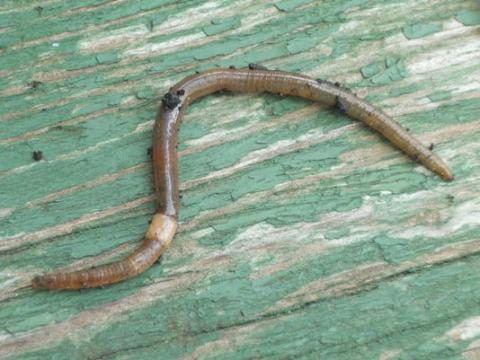
Photo courtesy of Wisconsin Department of Natural Resources
Jumping worms, also known as snake worms or crazy worms, are an invasive earthworm introduced to North America from eastern Asia.When jumping worms consume the upper organic layer of the soil, native plants may slowly disappear and invasive species take their place. As the forest floor structure changes, other species are negatively impacted, such as ground nesting birds, amphibians, and invertebrates.
Jumping worms alter soil structure more than any other worm. They are voracious, devouring the organic layer of the soil and leaving behind abundant coffee ground-like castings. Unlike other earthworms, jumping worms live and feed close to the soil surface. In woodland areas, they can quickly consume all of the leaf litter on the forest floor and make the upper layers of the soil feel grainy with their castings. While this change to the soil structure may not negatively impact cultivated bedding plants, it can be detrimental to native plants and animals.
While the extent of the jumping worm population is still unknown in New Hampshire, these worms may be found residing in gardens, compost piles, or adjacent woodlands. They are surface dwellers that tend to stay in the upper few inches of the soil. Jumping worms are brown to grayish in color with a smooth, white band (clitellum) that completely encircles the body near the head. Jumping worms are difficult to sight identify, but their behavior is unique and distinctive. Jumping worms tend to have firm bodies and writhe powerfully if you try to pick them up. They will occasionally lose their tails as a defense mechanism to escape predators. Jumping worms are also remarkably fast, and are snake-like in movement.
Start looking for adult jumping worms in June. While the adults do not survive the winter, their young persist in cocoons and reach adulthood in mid-summer.
Best Management Practices
- Do not buy or sell mulch, topsoil, compost, or plants that are infested with jumping worms.
- Carefully inspect garden materials for signs of jumping worms and their castings before bringing products home and introducing them to your landscape or garden.
- Be especially careful when sharing plant material at community plant sales and swaps. Jumping worms will readily crawl in to reproduce within nursery pots.
- Jumping worms are occasionally sold as fishing bait or for use in vermicomposting. Do not purchase them for these purposes, or any other purpose.
More About Jumping Worm
Invasive in the Spotlight: Jumping Worms UNH Cooperative Extension
Plant Sales and Jumping Worms UNH Cooperative Extension
Jumping Worm or European Nightcrawler? UNH Cooperative Extension
MEET THE Earthworms OF NEW YORK STATE New York State
Invasive Worms Entomology Research Laboratory at University of Vermont
Jumping Worm Field Guide Wisconsin Department of Natural Resources
Underground Invaders New York Invasive Species Research Institute
Great Lakes Worm Watch University of Minnesota Duluth

